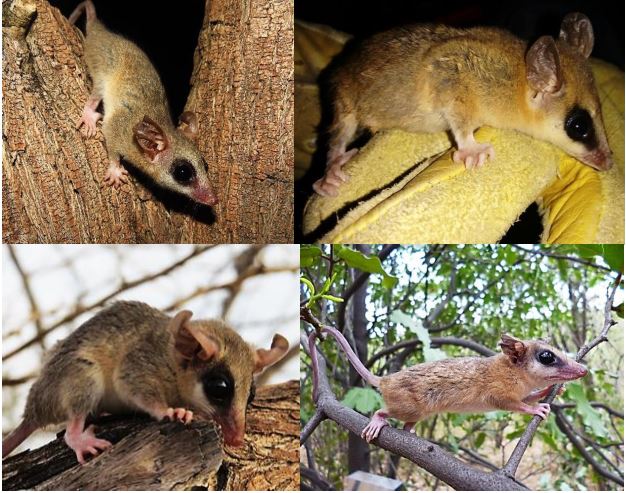Abstract
As part of the wildlife monitoring activities of the El Cerrejón mine, the abundance of the Marmosa xerophila and Marmosa robinsoni species was evaluated in three different sectors (secondary dry forest of the La Estrella area, riparian forest operated on the Tabaco stream and bushes restored in the Rehabilitation – Spring area) by capture with Sherman traps. Capture success was considered as a descriptor of abundance. Marmosa xerophila was not very abundant (n = 2) and restricted to the area of restored shrubs, while the Marmosa robinsoni species was found with greater abundance (n = 21) with presence in all sampled areas. Marmosa robinsoni is considered to be an abundant species because it can occupy transformed habitats such as those present in the study area and that Marmosa xerophila is at a disadvantage due to habitat transformation.
References
ALVIZÚ, P. & M. AGUILERA. 1998. Uso del espacio de Marmosa robinsoni (Didelphidae: Marsupialia) en una zona xerófila de los Andes venezolanos. Ecotropicos 11(2): 81–92.
BÁEZ, L. & F. TRUJILLO (eds.). 2014. Biodiversidad en Cerrejón. Carbones de Cerrejón, Fundación Omacha, Fondo para la Acción Ambiental y la Niñez. Bogotá, Colombia. 352.
CAUGHLEY, G. 1977. Analysis of vertebrate populations. John Wiley and Sons, New York, USA, 234.
DOMÍNGUEZ-HAYDAR, Y. & I. ARMBRECHT. 2011. Response of ants and their seed removal in rehabilitation areas and forests at El Cerrejón Coal Mine in Colombia. Restoration Ecology 19(201): 178–184.
FUNDACIÓN HIDROBIOLÓGICA GEORGE DAHL. 2006. Monitoreo de fauna en el valle del Cerrejón 2005-2006. Contrato con 00412005. Informe final.
GARDNER, L.A. 2008. American Marsupials. Pp 1–11 In Mammals of South America, Volume 1: Marsupials, Xenarthrans, Shrews, and Bats (Gardner LA, ed.) University of Chicago Press.
GOOGLE EARTH PRO V 7.3.1. 2018. La Guajira, Colombia. 11° 06’ 38.20” S, 72° 34’ 52.49” W, Eye alt 18,20 km. Digital Globe 2016. http://www.earth.google.com [mayo 26, 2018].
GUTIÉRREZ, E., et al. 2014a.Can biotic interactions cause allopatry? Niche models, competition, and distributions of South American mouse opossums. Ecography 37: 741–753.
GUTIÉRREZ, E., et al. 2014b. Phylogeography of Marmosa robinsoni: insights into the biogeography of dry forest in northern South America. Journal of Mammalogy 95(6): 1175–1188.
HANDLEY, C.O. JR. & L.K. GORDON. 1979. New species of mammals from Northern South America. Mouse Opossum, Genus Marmosa Gray. Pp 65–72 In: Vertebrate ecology in the Northern Neotropics (Eisenberg JF, ed.). Smithsonian Institution Press, Washington, D.C.
HOLDRIDGE, L. R. 1967. Life Zone Ecology. Tropical Science Center. San José, Costa Rica.
PÉREZ-HERNANDEZ, R. 2016a. Marmosa robinsoni. The IUCN Red List of Threatened Species 2016: e.T40506A22174162.
PÉREZ-HERNÁNDEZ, R., et al. 2016b. Marmosa xerophila. (errata version published in 2017) The IUCN Red List of Threatened Species 2016: e.T12815A115106154.
ROMERO-ALMARAZ, M., et al. 2007. Mamíferos pequeños: Manual de técnicas de captura, preparación preservación y estudio. Universidad Nacional Autónoma de México, Facultad de Ciencias, Instituto de Biología. Segunda edición, Navegantes de la Comunicación Gráfica, S. A. 203.
ROSSI, R. V., et al. 2010. A revision of the Didelphid Marsupial Genus Marmosa Part 1. The Species in Tate's ‘Mexicana’ and ‘Mitis’ sections and other closely related forms. Bulletin of the American Museum of Natural History 334: 1–83.
THIELEN, D.R. 1996. Ecología poblacional de Marmosa xerophila en un ecosistema semiárido del norte de Venezuela. Tesis de maestría. Postgrado en ecología tropical. Universidad de los Andes, Mérida, Venezuela. 233.
THIELEN, D.R., et al. 1997a. Population ecology of Marmosa xerophila in a semiarid ecosystem of northern Venezuela. Zoocriaderos 2(1): 1–19.
THIELEN, D.R., et al. 1997b. Selección de microhabitat por Marmosa xerophila (Marsupalia: Didelphidae) en un ecosistema semiárido del norte de Venezuela. Ecotropicos 10(1): 21–28.
THIELEN, D. R., et al. 1997c. Food availability and population dynamics of Marmosa xerophila Handley and Gordon 1979 (Marsupialia: Didelphidae). Zoocriaderos 2(1): 1–15.
THIELEN, D.R., et al. 2009. Rearing cycle and other reproductive parameters of the xero-phytic mouse opossum Marmosa xerophila(Didelphimorphia: Didelphidae) in the peninsula of Paraguana. Interciencia 34: 195–198.
VOSS, R. S., et al. 2014. Phylogenetic relationships of mouse opossums (Didelphidae, Marmosa) with a revised subgeneric classification and notes on sympatric diversity. American Museum Novitates 3817: 1–27.

This work is licensed under a Creative Commons Attribution-ShareAlike 4.0 International License.





